The Danish krone is the legal tender in Denmark and its autonomous overseas provinces (the Faroe Islands and Greenland).
Its ISO 4217 code is DKK and its symbol or abbreviation is “kr”, always written after the quantity. A Danish crown (danish crown or krone) is subdivided into 100 cents (øre).
As of the date of this post (October 5, 2022), the currency equivalents between the Danish krone and the euro are as follows:
- 1 euro = 7.44 Danish kroner (DKK).
- 1 Danish krone = 0.13 euro (EUR).
History of the danish krone
The Danish krone was introduced as the official currency of the Kingdom of Denmark in 1875, replacing the Rigsdaler.
In any case, various coins with the crown denomination were already circulating in the main cities of the country (Copenhagen, Aarhus, etc.) since the beginning of the 17th century.
The new crown was created simultaneously in three countries (Denmark, Sweden and Norway) to form the Scandinavian Monetary Union (between Sweden and Denmark on May 5, 1873 and Norway joining two years later in 1875). This Monetary Union remained in force until the First World War.
Despite this, the three countries decided to keep the name “crown” of their respective and, from that moment, different currencies, modifying their corresponding surnames (Danish crown DKK, Swedish crown SEK and Norwegian crown NOK).
The Danmarks Nationalbank (National Bank of Denmark) was the only body authorized to issue Danish kroner coins and banknotes until 2016. Since then this task has been placed in the hands of external companies subcontracted by the Danish central bank.
There is a project by the autonomous province of Greenland to independently mint coins and print kronor banknotes, although a start date has not yet been set.
Danish krone coins
The design of the Danish coins is intended to ensure that they are easy to distinguish and that people have security in their cash payments.
Following this criterion, the series is divided into three sequences, each with its own alloy and metallic color: bronze and aluminum gilding for the highest value coins (10 and 20 crowns), cupro-nickel silver for those of intermediate value (1,2 and 5 crowns) and bronze for the smallest (50 øre).
There are currently Danish kroner coins in circulation (all from 1875), with the following values:
- Danish cent coins (øre)*: 50 øre.
- Danish krone (kr) coins: 1 kr, 2 kr, 5 kr, 10 kr and 20 kr.
*The 5 and 10 øre coins were withdrawn from circulation in 1989 due to their low face value. The 25 øre stopped circulating on October 1, 2008 and was accepted for redemption until October 1, 2011.
On the obverse of all Danish coins appears the effigy of Queen Margrethe II, except for the 50 øre, which features the crown of Christian V, symbol of the Danish monarchy. As for the crown coins, the most characteristic is the 1 kr, easily recognizable by its central hole.
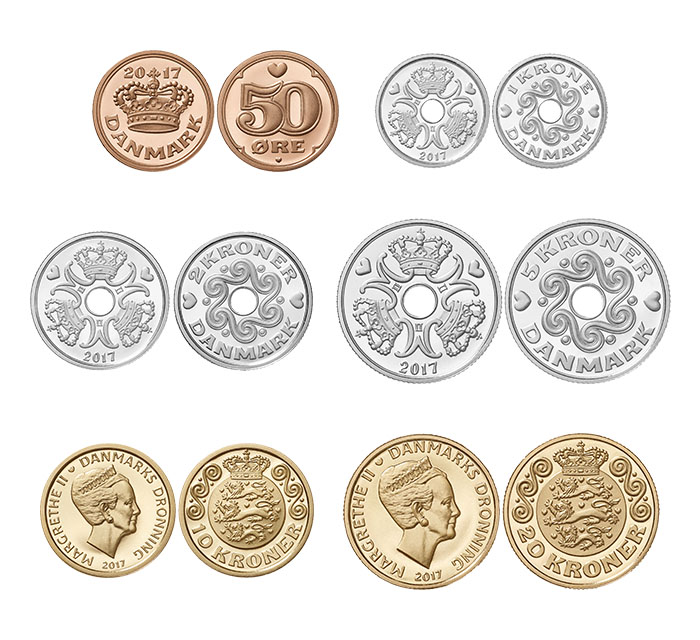
Danish kroner banknotes
The current series of Danish kroner banknotes was put into circulation between 2009 and 2011, although for the Central Bank, any banknote issued after 1945 is legal and can be exchanged for a current banknote without problem.
The current series is known as the “series of bridges”, since its obverses are decorated with images of different bridges from the country’s geography, with designs by the artist Karin Brigitte Lund. The obverses are dedicated to outstanding archaeological pieces from Danish prehistory.
Danish krone banknotes in circulation have the following denominations: 50 kr, 100 kr, 200 kr, 500 kr and 1,000 kr.
50 danish krone banknote
The central figure of this ticket is the Sallingsund Bridge, 1,717 meters long, which connects the island of Mors with mainland Denmark. The obverse shows the image of the Skarpsalling vessel, which dates back to 3,200 BC. This ticket is purple.
Its exchange value today July 19, 2022 is about 6.45 euros.
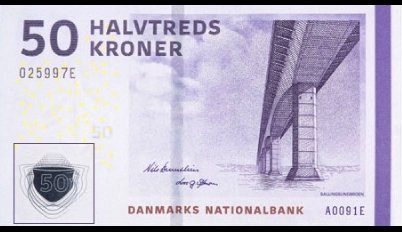
100 danish krone banknote
The orange (golden) 100 Danish kroner banknote features on its obverse the image of the Lillebaelt bridge, between Jutland and the island of Funen.
On the reverse appears a prehistoric dagger found on the same island.
Its current exchange value (July 19, 2022) is just over 12.90 euros and the Danes popularly refer to it by the name of hund (dog).
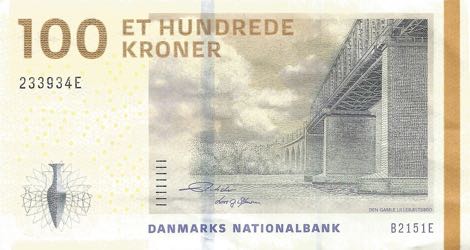
200 danish krone banknote
The Knippelsbro bascule bridge, in the port of Copenhagen, is the protagonist of the front of this banknote. The reverse is for the Langstrup Belt, one of the most representative archaeological pieces from the Bronze Age in Scandinavia.
This banknote is greenish in color and its equivalent value today, July 19, 2022, is around 25.80 euros.
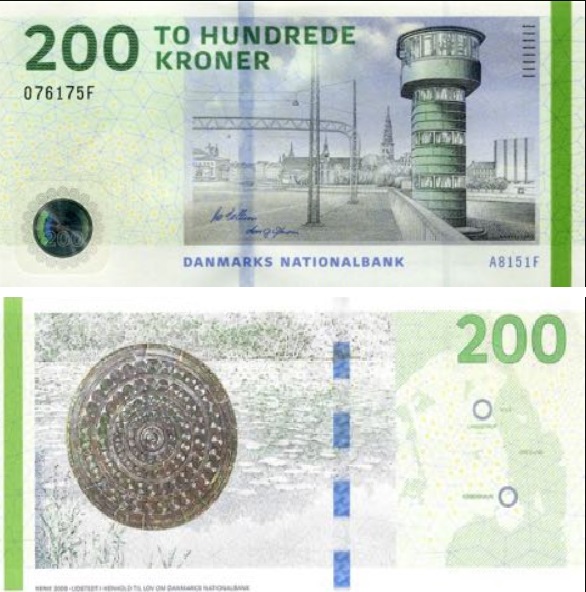
500 danish krone banknote
The color chosen for the 500 Danish kroner note is blue. On its obverse appears the Queen Alexandra Bridge, better known in Denmark under the name of Møn.
The reverse shows the Keldby bronze cube, found in Danish lands but probably made in Greece 2,500 years ago.
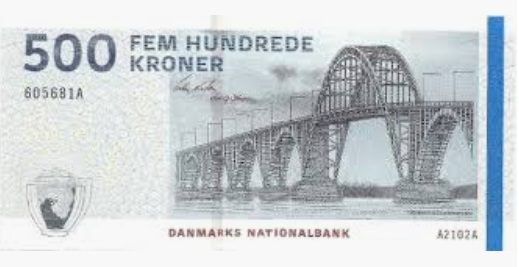
The equivalent value of the 500 Danish corina banknote in euros, today July 19, 2022, would be 64.50 euros in France.
1000 danish krone banknote
The highest value Danish kroner banknote is red in color and features on its front a beautiful image of the Storebæltsforbindelsen, a 6.7-kilometre-long bridge that connects the island of Funen with the Jutland peninsula.
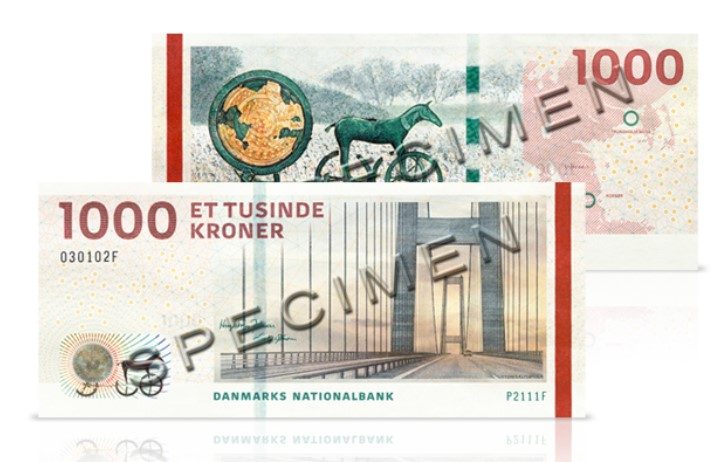
On its obverse the famous “Sun Chariot” is shown. Its approximate value at the current exchange rate of about 129 euros (today July 19, 2022).
Euro to Danish krone exchange
The exchange rate of the euro against the Danish krone is relatively stable, only subject to slight fluctuations.
If you search Google for “Danish krone euro exchange” you will find dozens of websites (“currency converters”) that offer a “rate” of the day.
You will also see this chart with the rates of that currency pair from Google Finance. Something like this (July 19, 2022):
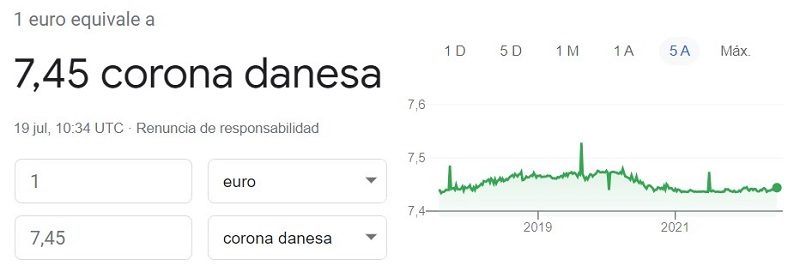
As you can see, the change in recent years has hardly moved outside the range that goes from 7.44 DKK to 7.61 DKK per euro, but keep in mind that this graph represents the value of the “ currency” Danish krone against the euro, and not that of the real currency, which is lower.
In fact, in currency suppliers in France you can buy Danish kroner at an exchange rate of around 7.26 DKK per euro in the best of cases, with Comparer Devise, and the 6.19 kroner per euro that They will give you at the Paris Roissy CDG Airport (Global Exchange).
Nothing to do with the Danish krone euro currency exchange of 7.45 kroner per euro today July 19, 2022.
So, when you see these values in Google and other currency converters with your mobile, you should keep in mind the following:
- This is an unofficial rate, and therefore not reliable. That is, if you click on the “Disclaimer” link, you get this warning from Google Finance: “Google cannot guarantee the accuracy of the exchange rates displayed. Please confirm the current rates before making a transaction that may be affected by changes in exchange rates.”
- These rates that you see are usually wholesale rates of the Danish krone currency against the euro currency (currency and travel money are not the same).
- This rate can only be obtained by banks among themselves, that is, it is impossible to obtain it as an individual. That is, what is known as the “interbank market” for foreign exchange.
If you need Danish kroner in banknotes you will have to go through the retail banknote market (bank or exchange office). This market means that the crowns have had to be “transported” by someone for you to enjoy them (or bought from travelers from Denmark passing through France previously).
In other words, moving DKK banknotes from one place to another has logistical costs that will make their sale rate more expensive (the exchange rate that whoever sells them will apply to you).
The Danish krone is not a very abundant currency in France, although it is not very difficult to obtain. Despite this, its rate is logically more expensive in France than in Denmark. If you decide to buy Danish crowns in France, it is good to anticipate the purchase and order them online to get a better rate.
Where to exchange danish kroner
The two most popular places to exchange Danish kroner in France are banks and high street currency suppliers or currency suppliers at the airport.
Needless to say, we rule out changing at a hotel, since there they will not apply a competitive exchange rate, they will charge you an additional commission. And besides, they will surely round you up to give you the DKK banknotes they have.
Change danish kroner at the airport
Of these, the least recommended place to buy is the airport, since they are very expensive places where the profit is shared by the currency supplier that operates in it -Global Exchange- and the airport manager (Groupe ADP and others in France).
Changing danish kroner at your bank
The big French banks all change Danish kroner. But be careful because in addition to an exchange rate where they earn money, they will also apply a commission of 2.5 to 3% on the amount exchanged, with a minimum of between 10 and 15 euros.
This means that if you change 100 euros to Danish kroner, you will be charged a fixed commission of 15 euros (15% of your money) and only 85 euros will be changed to Danish kroner. And if you change 1000 euros to Danish kroner they will keep 30 euros and will only apply the exchange rate on 970 euros. Keep that in mind.
Euro to Danish krone exchange rate today
To find out the euro-Danish krone exchange rate, the best thing you can do is use our currency comparator, which is free for you:
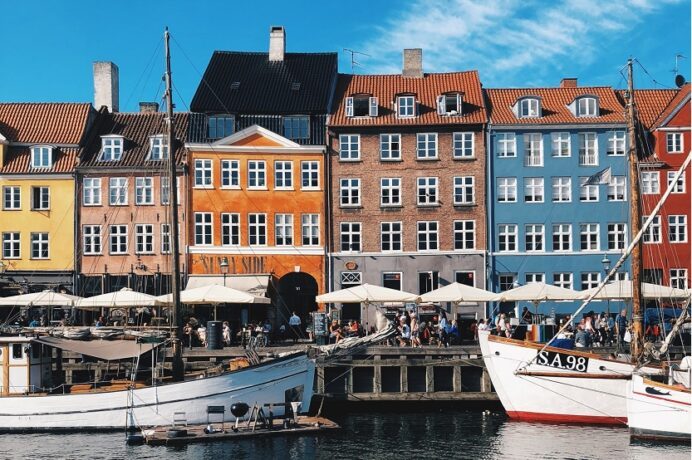
Sin comentarios